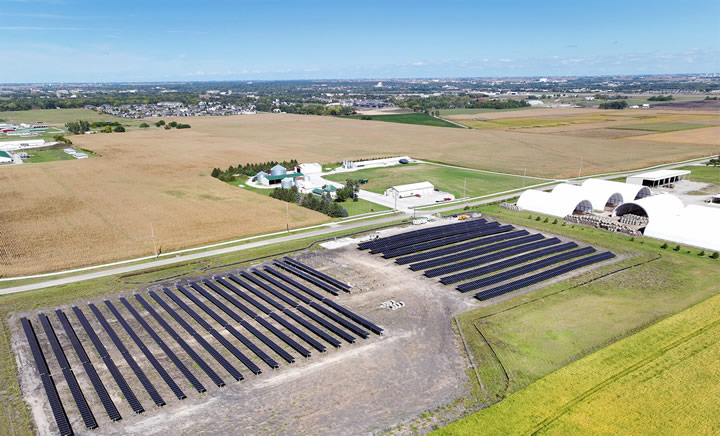Ideal Energy Designs Groundbreaking 'Agrivoltaics' Solar Array alongside Iowa State University Scientists

In a pioneering initiative, Iowa State University (ISU) is embarking on a research project to explore the combination of crops and solar power. The Alliant Solar Farm at Iowa State University is a groundbreaking agrivoltaics research project merging solar power generation and agriculture to study how best to optimize land use while providing local community benefits. The array was inaugurated on Thursday, October 19th with a ribbon-cutting ceremony.
Horticulture and agriculture students will plant crops to study how they perform under solar arrays of various heights and configurations. Engineering students will review solar production data to see how various crop plantings impact solar production.
The research project received a four-year $1.8 million grant from the U.S. Department of Energy via a program called Foundational Agrivoltaic Research for Megawatt Scale (FARMS). ISU was one of only six recipients of the $8 million dollar program. The research team is led by Ajay Nair, Associate Professor of Horticulture; Matt O'Neal Professor in Plant Pathology, Entomology and Microbiology; and Anne Kimber, Director of the Electric Power Research Center.
"As renewable energy grows, it's important to find opportunities for these projects to benefit people, beyond just providing renewable electricity. There's good work to be done on this front, and we hope this research and demonstration will help identify the potential for communities to benefit from agrivoltaics," said Anne Kimber, co-principle investigator.
The project is a collaboration between ISU and Alliant Energy. Alliant Energy owns and operates the solar array on land leased from the university. Waldinger Corporation was the general contractor for the project. Ideal Energy was subcontracted for solar design, procurement, monitoring, and solar commissioning for the project. Ideal Energy designers worked with ISU researchers to design a variety of solar configurations for testing purposes. Shive-Hattery, Inc. provided civil and electrical engineering services for the project.
Ideal Energy designed the 1.757 MWDC / 1.375 MWAC solar field in two parts. One part is an 811 kWDC fixed-tilt solar array facing south. Six fixed-tilt rows have a standard leading edge of two feet off the ground in front and three rows have a leading edge height of five feet to test to see if higher solar arrays create better growing conditions. The second part is a 946 kWDC single-axis active tracker. Eighteen of the active-tracker rows are a standard five to six feet above the ground while five rows are eight to nine feet above the ground. All solar panels on the site are bifacial, meaning they generate power from both sides.
Researchers plan to explore which crops thrive in a modified solar microclimate. They plan to plant vegetables, fruits, and pollinator habitats. They also intend to study how solar site maintenance impacts cultivation.
"Growing these types of crops under and around a solar farm on a scalable basis is different than just growing them. We want to demonstrate that's possible," said Ajay Nair, lead principle investigator.
Comments (0)
This post does not have any comments. Be the first to leave a comment below.
Featured Product

